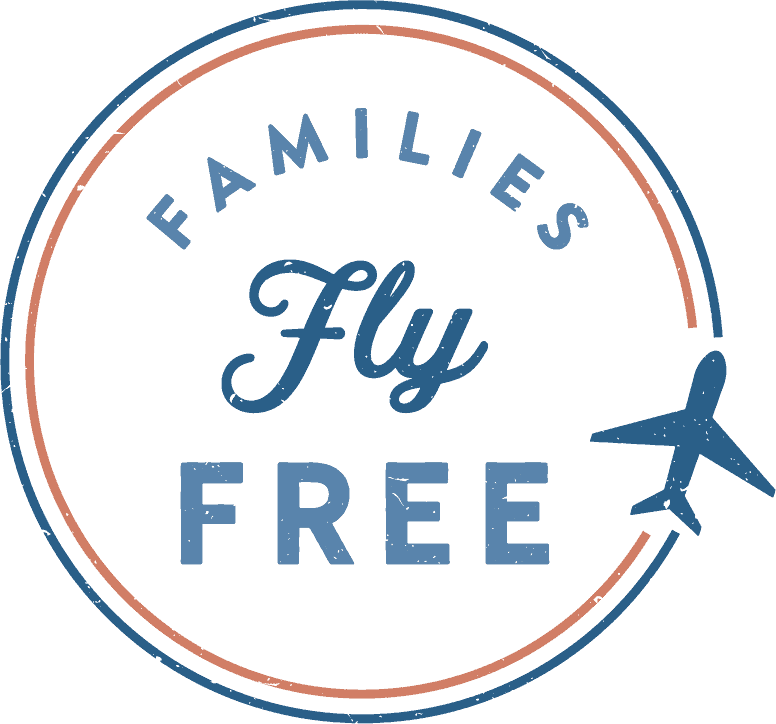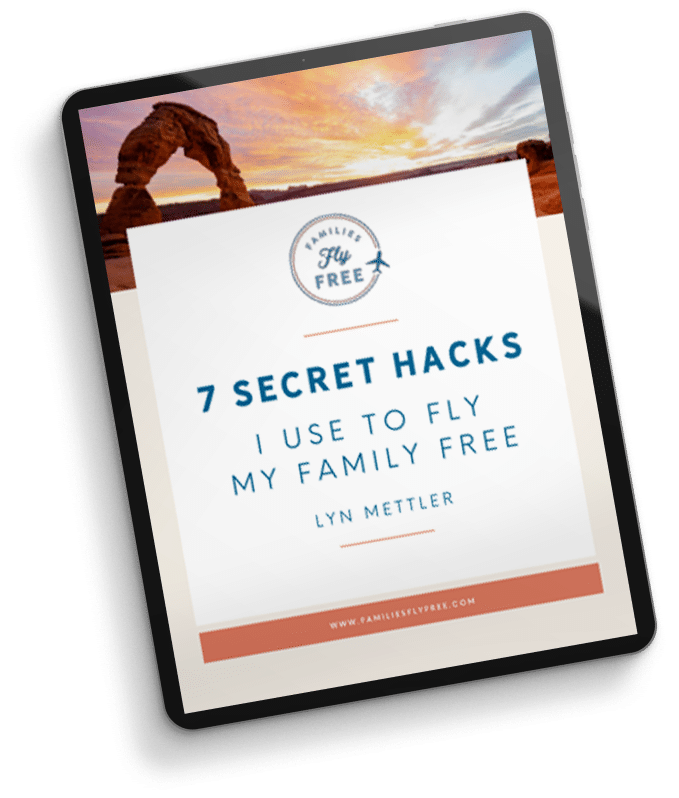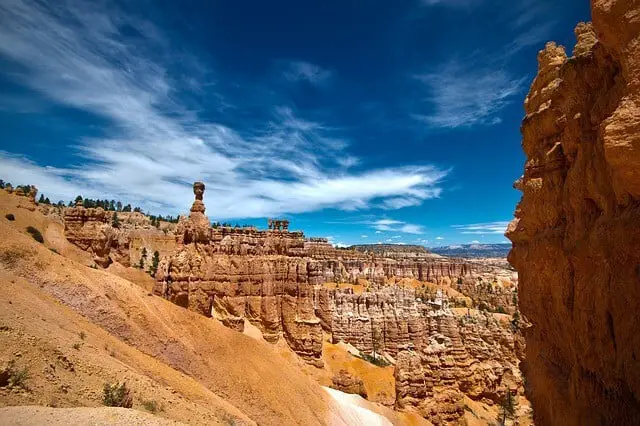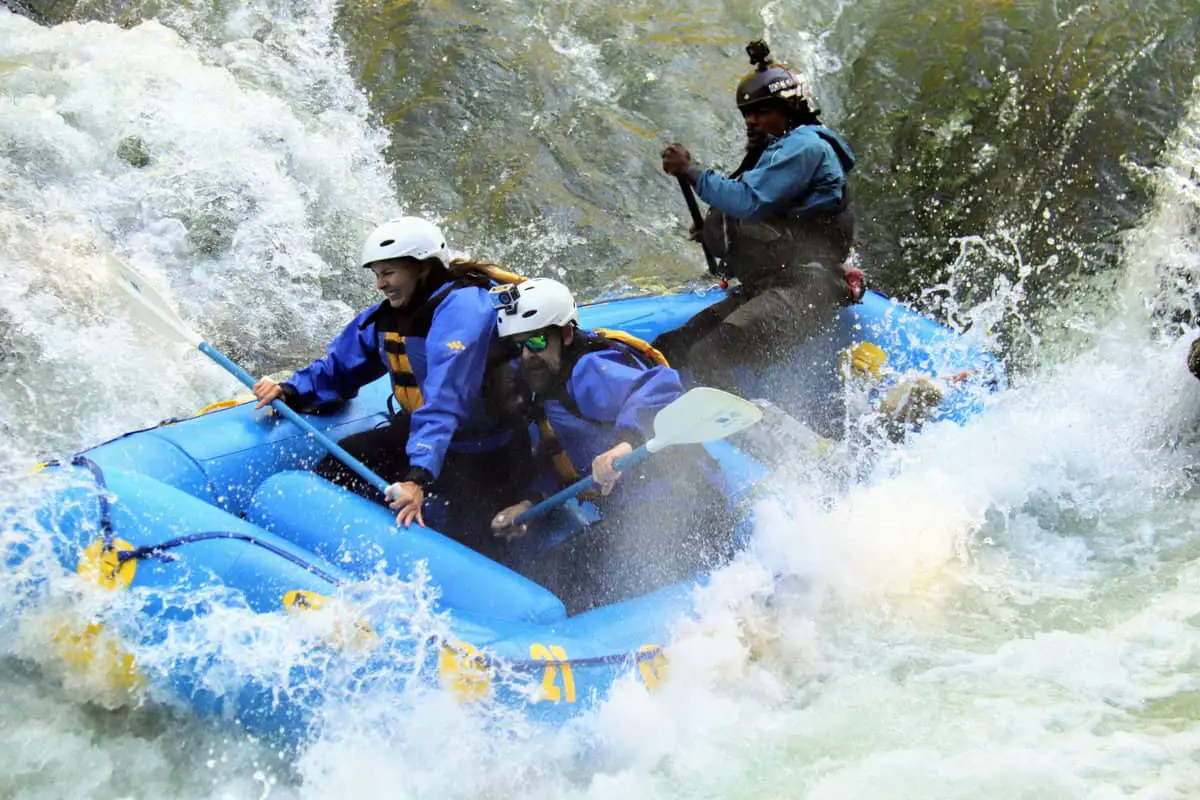Named by early pioneers, Zion National Park, means a place of refuge and peace.
It’s a great place to take a break from ordinary life for a few days and find sanctuary in its massive sandstone canyons and cliffs full of beauty. Truly a hiker’s paradise!
Here’s our Ultimate Guide to the glorious, must-see Zion National Park where all our Families Travel Free team members have visited…
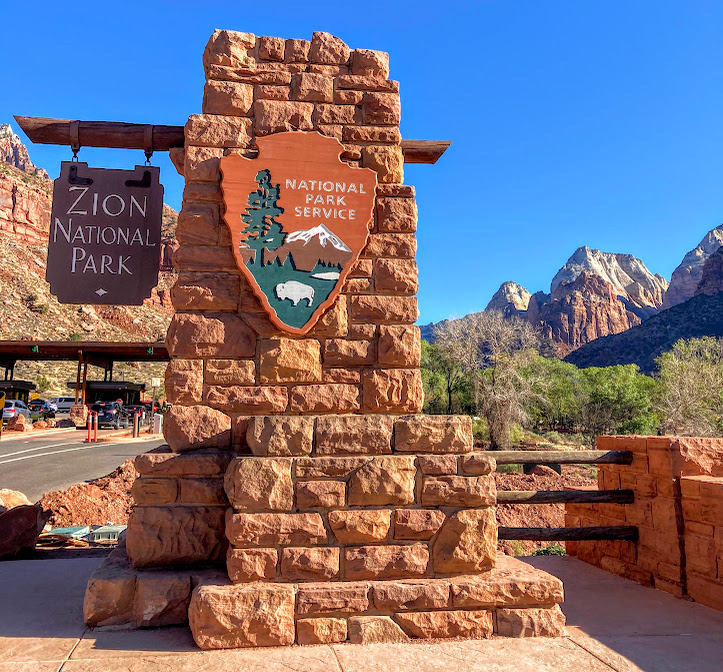
Want to learn the EASY way to fly for free by collecting and redeeming travel rewards? Join us in Families Fly Free, the premier online travel club where you can learn our SIMPLE, step-by-step system and save thousands of dollars in the process, while enjoying 1-on-1 support, a vibrant community and timely travel webinars and alerts. It's helped hundreds of families and thousands of people be able to travel MORE while spending less -- all while making priceless memories with their families.
The price of Families Fly Free, temporarily lowered in January 2024, is about to go back up, so there's no better time to join than NOW, the LOWEST price it's ever been available! We have limited slots left at this price and will increase the price once we reach capacity. Don't put off traveling with your family any longer. Tomorrow is not guaranteed.
See what members have to say...
The Ultimate Guide to Zion National Park
Do “The Mighty 5”
One thing to consider if visiting Zion is to visit the other 4 Utah National Parks: Bryce Canyon, Capitol Reef, Canyonlands and Arches. These parks are known as “The Mighty 5.”
The sites and vistas? Wow! Well worth it. Watch this video from Visit Utah for a sampling. Goosebumps… 🙂
Getting to Zion National Park

Southwest Airlines flies into Zion’s nearest airport, Harry Reid in Las Vegas (formerly McCarran), though it is still a 2.5 hour drive away; however, how fun is it to hang out in Vegas for a few days before or after?!
[Read our list of 32 Incredible Things to Do in Las Vegas]
When you use your Southwest points and Southwest Companion Pass to fly to Vegas, you’ll beat the odds indeed 😊, saving a boatload on your trip.
Lyn and her family spent a few days in Vegas, showing it to her kids for the first time, wandering through all the amazing hotels and swimming in Mandalay Bay’s epic water park!
HOT TIP: If time permits while you’re in Las Vegas, drive over and check out Hoover Dam. Read more about that in our above “Things to do in Las Vegas” post.
Or as an alternative, if you love the great outdoors as much as I do, you could visit Valley of Fire State Park or Red Rock Canyon in Nevada and Snow Canyon State Park in Utah on your way to Zion.
Driving in Zion National Park
When you drive into Zion National Park, you’ll be struck by its majesty.
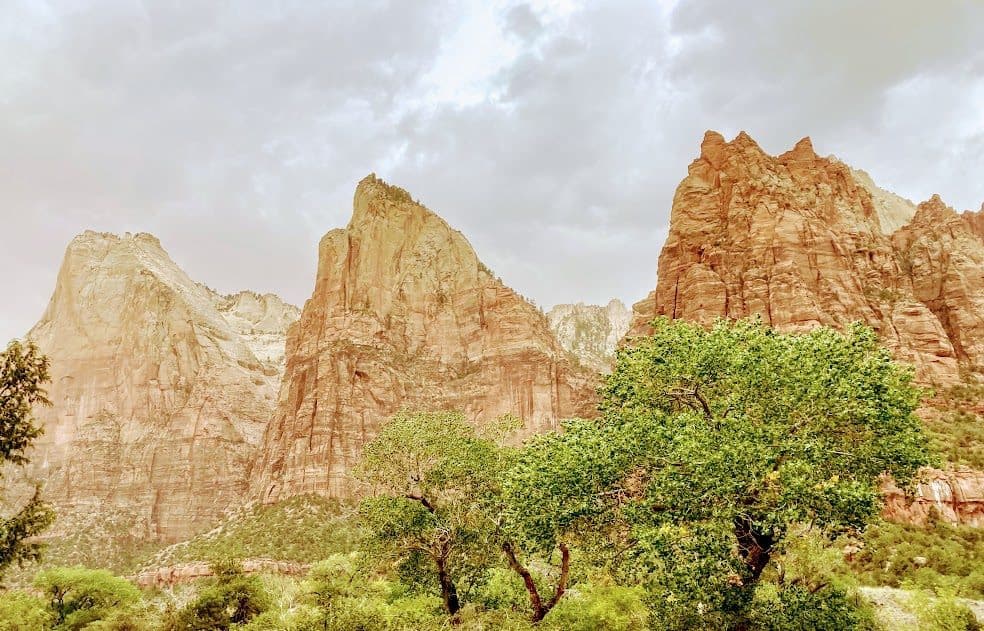
Soaring rocks and mesas with unusual patterns and varying shades of red make you feel as though you’ve arrived on another planet. Who knew the U.S. had landscapes like this?
Soon after driving into Zion, Lyn and her family came upon big-horned sheep battling in the road–just my kind of traffic jam! It caused a backup, of course, but that kind of sighting is always worth it.
One of the best parts of driving in Zion are the tunnels. If you plan on driving an RV, which is 11’4″ tall or taller or 7’10” wide or wider, including mirrors, awnings and jacks, you will need a tunnel permit to drive through the Zion-Mt. Carmel Tunnel. Check the link, as there are restricted hours for this as well.
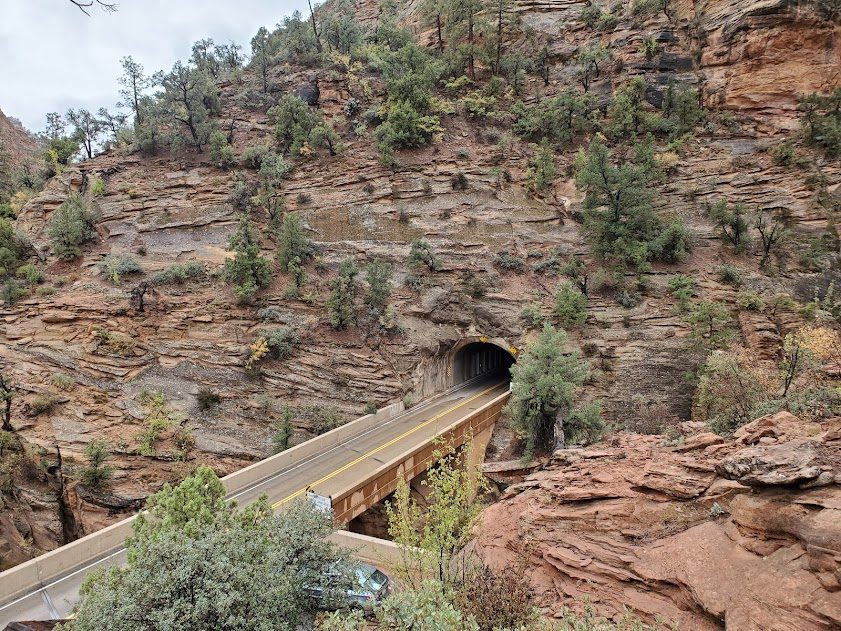
Parking is limited at Zion, and usually fills before 9 or 10 a.m. every morning. We suggest doing a quick drive through the nearby lot even if it says it is full. We’ve learned over the years that full (several spots still left) doesn’t necessarily mean full (no spots left)!
If you don’t get a spot, head to nearby Springdale, where you can catch a free Zion Shuttle Bus (more information below).
Entrance Fees

The park entrance fee is $35 per car and $30 per motorcycle for a 7-day pass.
Senior citizens can purchase a lifetime senior pass that covers ALL national parks for $80 or instead choose a $20 annual pass. The best part? Everyone in your car ALSO gets in with your senior pass. Nifty… 😉.
Are you an active military member, veteran or Gold Star family? Grab a FREE pass and thank you for your service!
If you plan on visiting more than 2 National Parks in a year, opt for an America the Beautiful annual pass for $80 to save money.
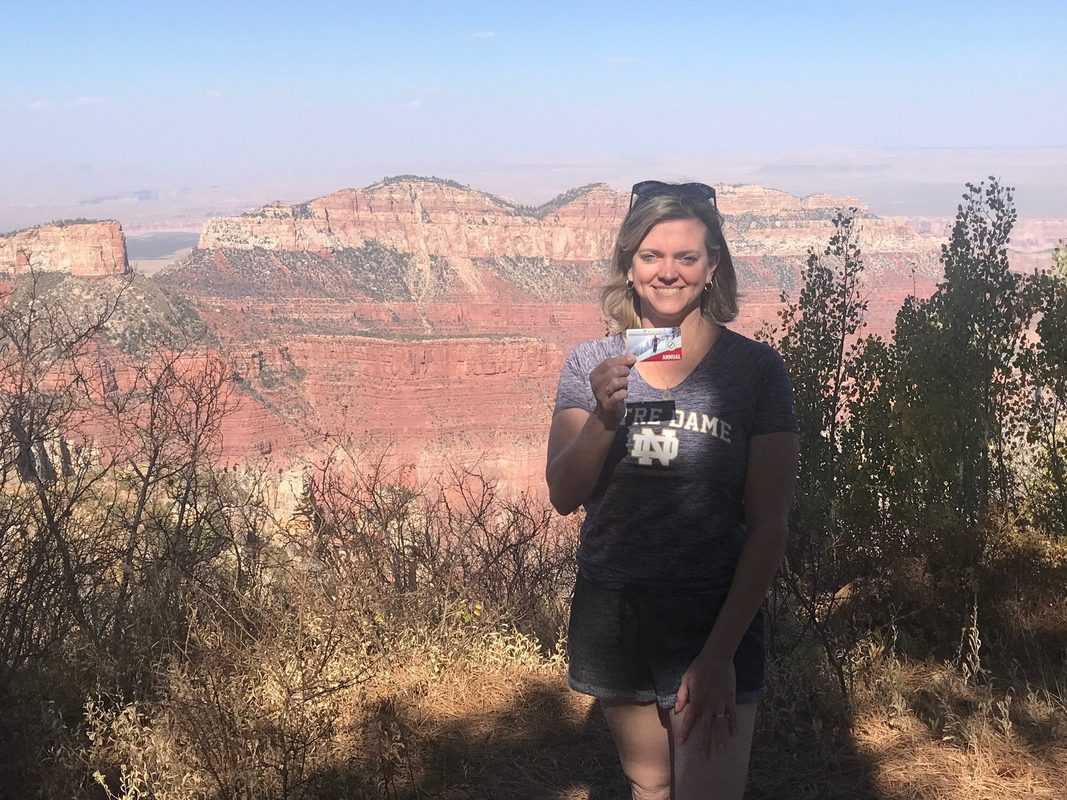
INSIDE TIP: Want to volunteer in a national park? If you acquire more than 500 hours of service, this entitles you and three others to visit National Parks free for a year.
And, don’t forget, if you have a fourth grader, your whole family gets into National Parks, as well as lands and waters, absolutely free during their school year and the following summer until August 31, as part of Every Kid Outdoors.
You can also access Zion National Park FREE in 2024 on the below days, but keep in mind these days will be even MORE BUSY than usual:
| January 15 | Birthday of Martin Luther King, Jr. |
| April 20 | First day of National Park Week |
| June 19 | Juneteenth |
| August 4 | Great American Outdoors Act Anniversary |
| September 28 | National Public Lands Day |
| November 11 | Veterans Day |
Zion National Park Weather

This National Park is far enough south that the months of June, July and August have no snow, but in return, the temperatures range from a low of 60 to a high of 100 blistering degrees!
For milder temps, try the shoulder seasons, which include April, May, September and October. We visited in October where one day it was 70 and that evening, it rained in town but snowed on the mountain tops. Lyn’s family visited in April and found cool mornings but afternoons that warmed up quickly into the low 80s. Layers are key!
It’s the wettest in March, which means snowmelt through May can make the rivers dangerous, meaning The Narrows (more below) may be off-limits. You may find, however, lots of wildflowers in bloom from April through June.
Because of the broad range of temperatures, this park has a longer season than most, which, hopefully, means that it’s a lot less crowded too!
Getting Around Zion

The best, and sometimes only, way to get around Zion (when the shuttle is running, no private vehicles are allowed on the Zion Canyon Scenic Drive) is by free shuttle bus. Shuttles leave frequently from the Zion Canyon Visitor Center, which run from early spring through late fall and allow you to hop on and hop off at any of the stops, which is especially helpful if you’re hiking.
Depending on the time of day and time of year, the wait time can be as short as 5 minutes or as long as 30, so keep this in mind. Shuttles also have room for two bicycles.
The system has 2 different loops:
- A 9-stop loop in Springdale takes you to the pedestrian entrance to the park where you can get your park guide and map and then hop on
- A 9-stop loop which runs from the visitor’s center to the Temple of Sinawava in the canyon, an 80-90 minute round-trip ride.
Some tips when taking these shuttles:
- Don’t forget to bring your park pass or receipt to get into the park if you came from Springdale!
- Make sure you know the departure time of the last shuttle of the day and don’t miss it!
Where to Stay
Zion National Park Lodge
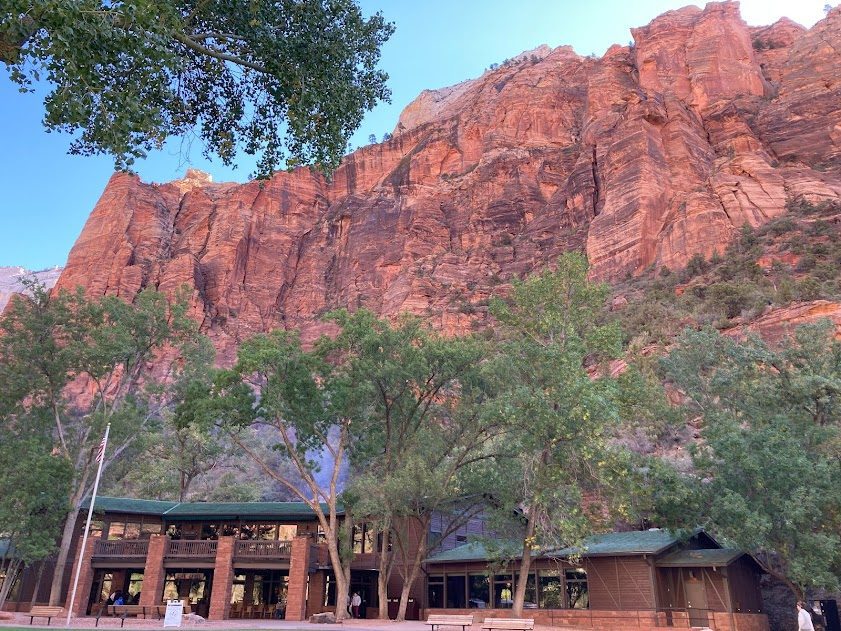
The ONLY in-park lodge, Zion National Park Lodge, built in 1924, is close to the Lower Emerald Pool Trail. Accommodations there include hotel or suite rooms in the lodge, as well as 28 cabins within walking distance.
It features a grill that serves breakfast, lunch and dinner and a seasonal cafe and gift shop. Even if you aren’t able to book a room here, it’s a great place to recuperate with a meal or snack before continuing your outdoor activities!
Nearby Cities
Springdale, Utah
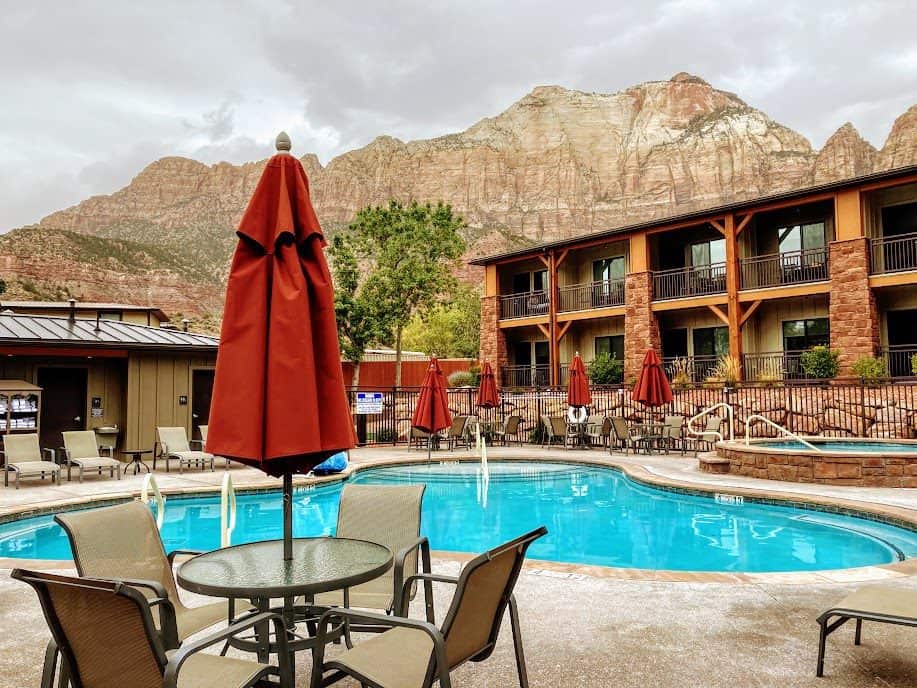
Because parking is limited and lots can be full by mid-morning, the National Park Service suggests Springdale, Utah as a convenient place to stay. Major hotel sites list around 30 hotels there, not including other options such as B&Bs, private rooms, cabins and glamping.
The advantages to staying in Springdale? Proximity to Zion (mere minutes) and the ability to get into the park using the free shuttle bus.
One great option is the Best Western Plus Zion Canyon Inn and Suites. See our video tour below of a room there.
Within 15 minutes of the park by foot and on shuttle stop No. 4, this hotel has oversized rooms in the latest decor with…
- microwaves
- mini-fridges
- coffee makers
- balconies with mountain views
Fill up on their hearty free breakfast buffet so you’ll be ready for a full day in Zion.
After hiking in the park, take advantage of their outdoor fire pit to relax by or soak your weary bones in the hot tub. Kids will enjoy the sparkling pool and moms will like the onsite laundry if needed.
Kanab, Utah
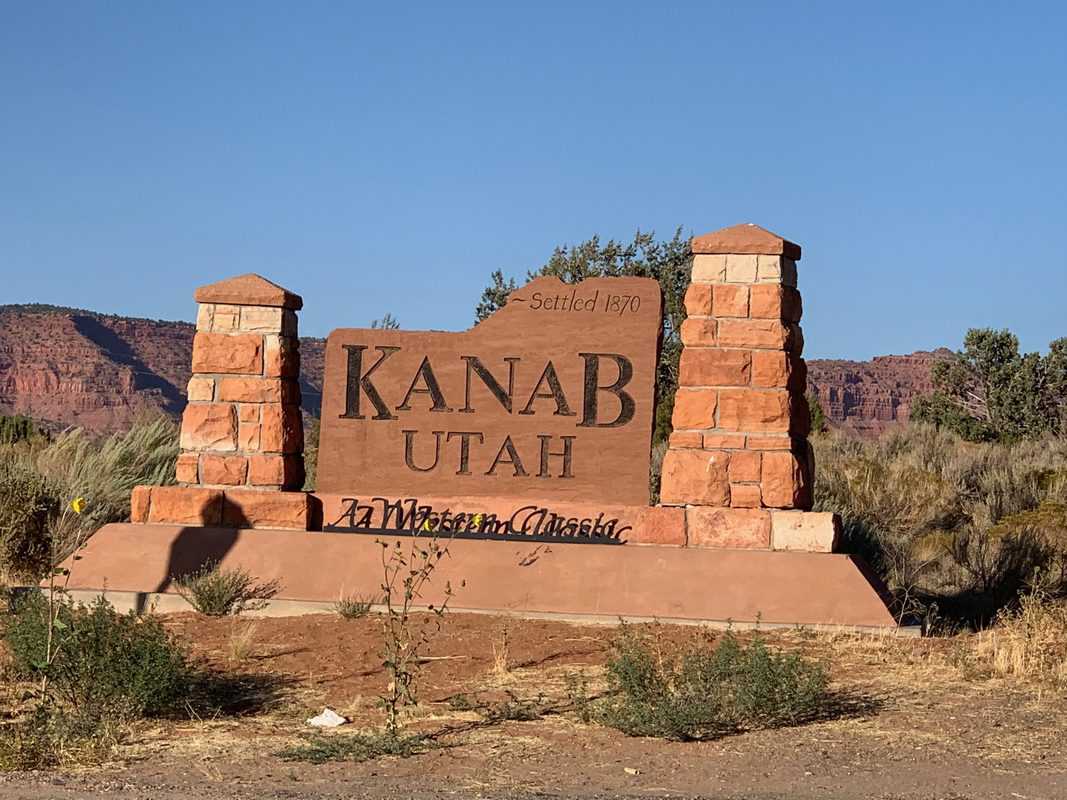
Kanab is a bit further away but is a town filled with character! This is where Lyn and her family called home during their visit to Zion and also on their way to Capitol Reef, Arches and Canyonlands National Parks on a separate trip.
What to Do in Kanab
Fans of Westerns will love Kanab, where more than 100 movies and TV shows have been filmed. Check out the Little Hollywood Movie Museum on West Center Street to see some movie sets.
You’ll also find Best Friends Animal Sanctuary in Kanab, which offers free tours and opportunities to volunteer.
Peek-a-Boo Slot Canyon
And in case you didn’t get enough hiking in Zion, Kanab has its own Trails System accessible from town or check out the local-favorite Peek-a-Boo slot canyon without the hoards of people you’re more likely to find in Zion.
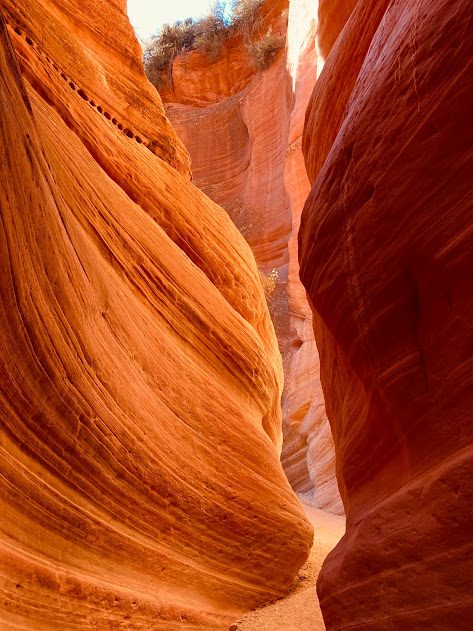
You’ll need to hire a tour company to reach Peek-a-boo Canyon if you don’t have a 4×4. We opted for the 8 a.m. tour with Coral Cliffs Tours where our group was one of the first to the site, making for great photos.
Check out my visit to Peek-a-book Canyon in the video below…
Coral Pink Sand Dunes State Park
Kanab is also convenient to Coral Pink Sand Dunes State Park, which you should definitely check out when in the area.
You can “sand surf,” which is SO fun! Go to the highest dune, sled down with your fingers dragging the sand to steer (I learned this the hard way!) and then walk the ridge back up. We timed it and, 20 minutes later, were back up top, a little less exhausted than trying to climb straight up the dune!

Where to Stay
Holiday Inn Express

Lyn’s family stayed at the Holiday Inn Express, and since it was so cheap, upgraded to a suite with two bedrooms.
Please note this is an affiliate link for which we may earn a commission if you make a purchase after clicking through. Thanks for supporting our free content!
The property is very nice, has laundry for washing your dirty hiking clothes and offers an excellent hot filling breakfast to fuel you for a day of hikes!
Or check out the Best Western Red Hills where we stayed. I loved all the photography lining the halls of this hotel, some taken from the parking lot!
See the video below for a tour of our room at this hotel…
With an outdoor pool and hot tub, free breakfast buffet, game room and fitness room, there’s something for everyone to enjoy here. They even have an outdoor gas grill and picnic area for guests to use.
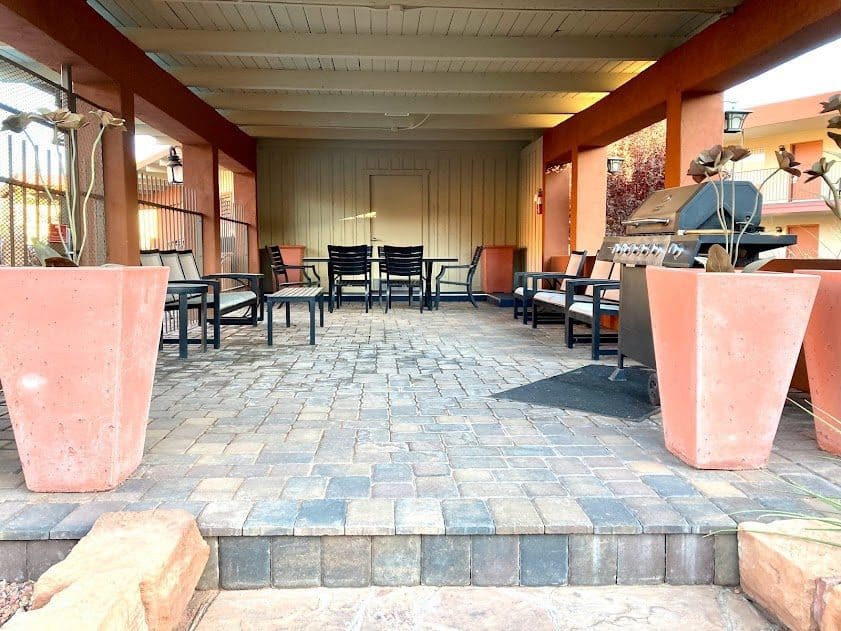
Mt. Carmel, Utah
Close to Coral Pink Sand Dunes State Park and east of Zion is Mt. Carmel. You’ll find plenty of outfitters here, even more slot canyons to hike, as well as Maynard Dixon Gallery, highlighting this famous artist’s work.
When you stay in Mt. Carmel, you enter Zion from its beautiful east side along the Zion-Mt. Carmel Highway through the historic tunnel. Your jaw will drop, we promise!
Zion Mountain Ranch
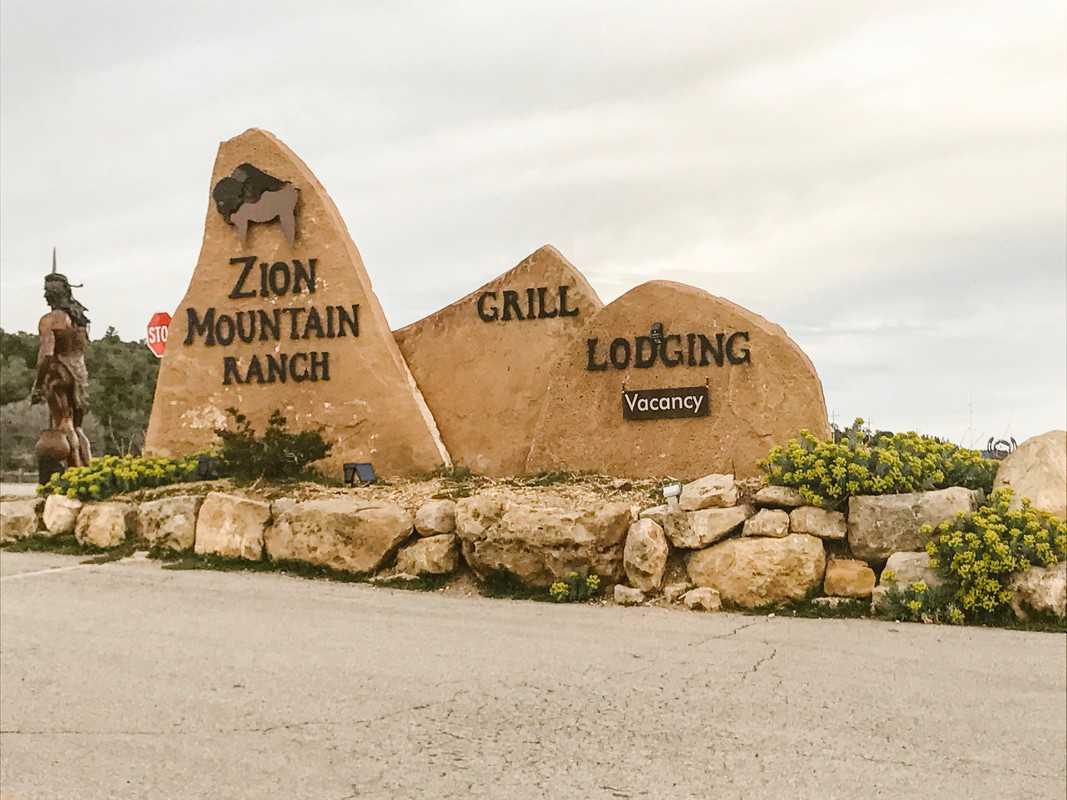
Also east of Zion National Park is Zion Mountain Ranch, which gives you the opportunity to stay on the same property as a herd of buffalo! Choose from private cabins or large lodges for your overnight stay that will feel truly “western.”
Even if you choose not to stay here, Lyn recommends heading over to their Cordwood restaurant for dinner one evening.
Things to Do in Zion National Park
Hiking
Always check ahead of your trip to see if you need permits to do specific hikes like Angels Landing. Check again with the rangers once you arrive to see if any of your chosen hikes are closed that day like The Narrows, which closes if the water is too high.
Some hikes can also be closed because of rock slides or other weather-related issues.
Here are some hikes to consider on your visit to Zion…
Upper Emerald Pools Trail (shuttle stop #5)
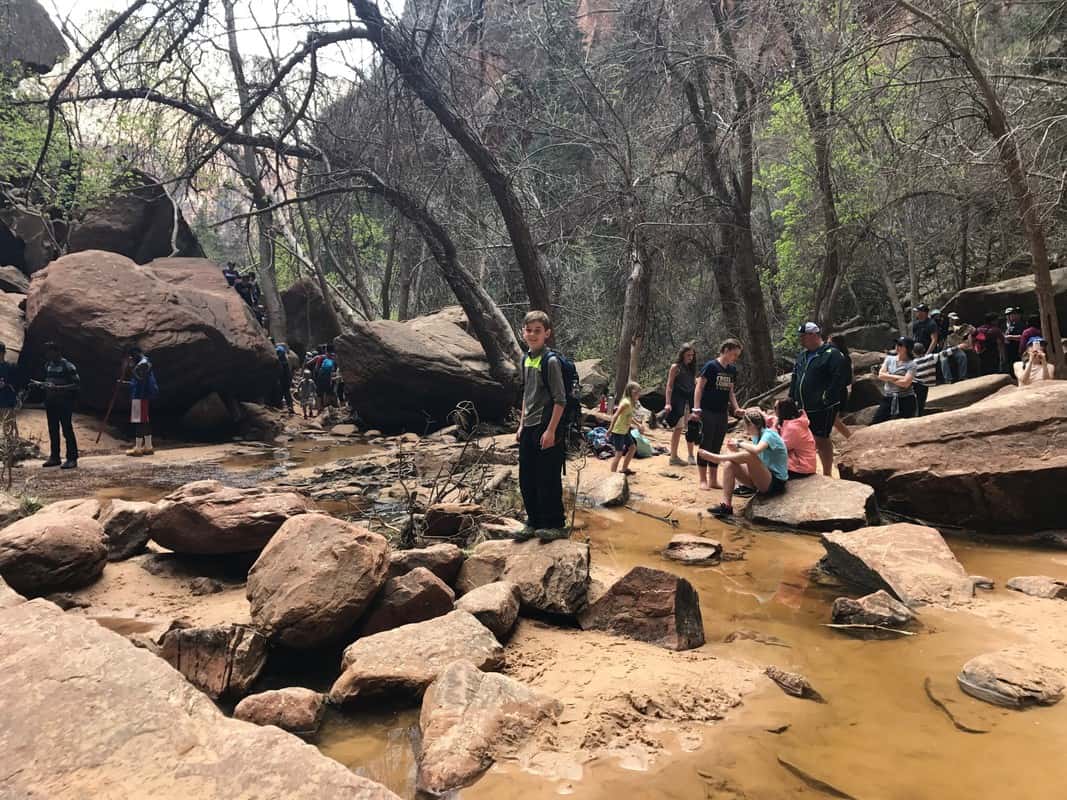
This is an easy hike, taking you a little over a mile on a paved trail that should take only about an hour. Hike to the back of the pool even further for some seclusion when it is crowded.
It’s perfect for all ages with a great payoff: pools of water and a 30-foot waterfall. Plus, if you have kids that like rocks, like Lyn’s son above, they can rock hop to their heart’s content! You can combine this with the Lower and Middle pools to make ~3 mile round-trip hike.
Angels Landing via West Rim Trail (shuttle stop #6)
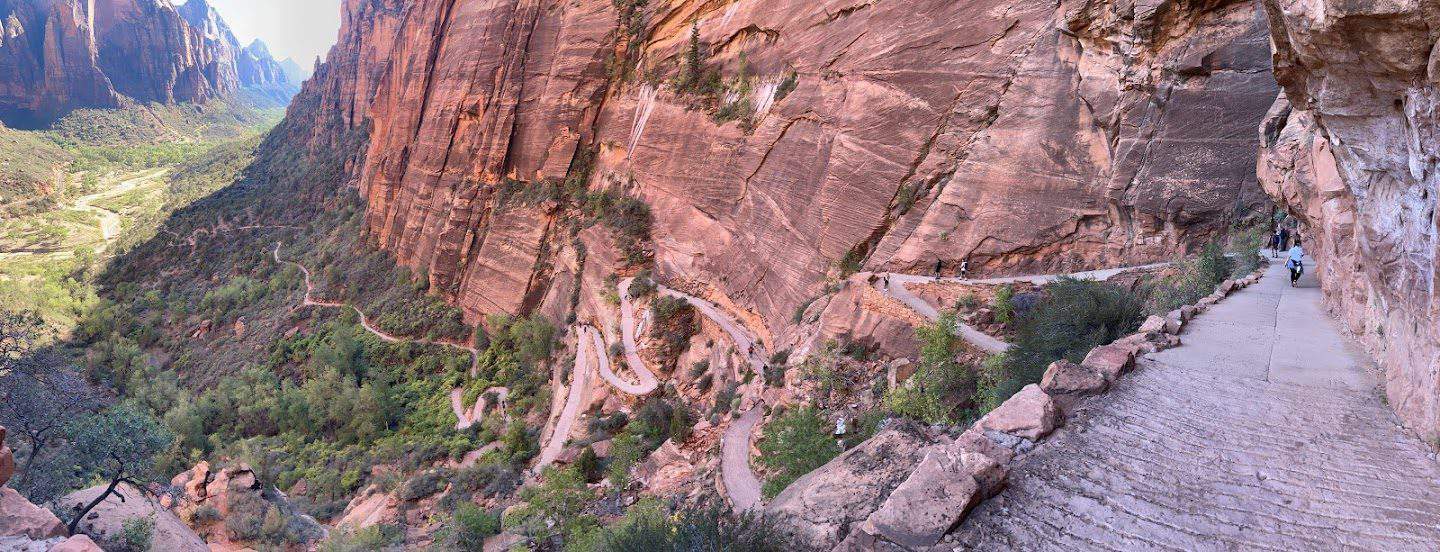
Check to see if reservations are needed to do this hike, as mentioned above, and secure those far in advance on the recreation.gov site. You won’t need a permit unless you are going ALL THE WAY to the top. This is a strenuous and — scary! — 5.5 mile trek with an elevation gain of almost 1,500 feet, the second-highest of Zion’s 18 listed hikes.
If you do this trail to completion, you go along a portion with steep drop-offs on either side with only chains to cling to for dear life. It’s not for the faint of heart, kids or anyone with a fear of heights! There’s also a section of many switch-backs famously called “Walter’s Wiggles.”
If you want to skip the scariest parts, you can just go to where the chains start at Scout Lookout, no permit needed. You’ll be rewarded with views even at that point.
So, why list this as a best hike? It’s the most often talked about hike in Zion and if you make it to the summit, you’ll have outstanding views not everyone gets to see. Plus, you’ll be pretty impressed with your courage 😃 .
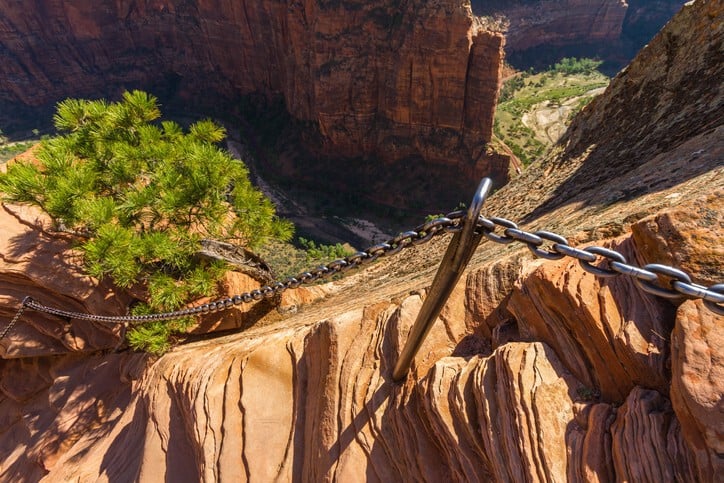
Ask a ranger if you’re unsure if you should do this hike and take a look at our video below to get a feel for what it’s really like, so you can make a prudent decision concerning if this hike is for you…
The Narrows (shuttle stop #9)
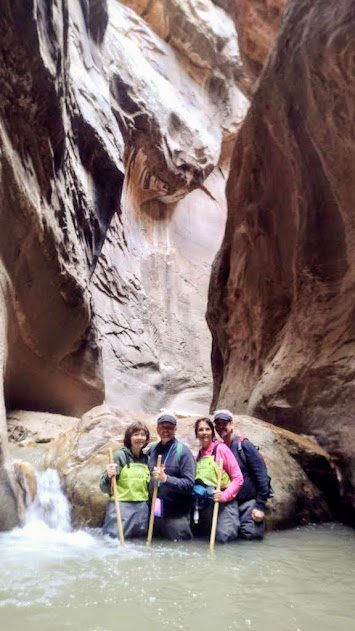
The Narrows is the other most popular hike in Zion, as this one literally takes you through a river inside a slot canyon, considered the “grandfather of all slot canyons” for its magnificence and grandeur.
While often closed during the spring due to the height of the water, those who get to hike the Narrows will wade through the knee-deep Virgin River with 2,000-foot high rock walls on either side. If you thought hiking was hard, try hiking through a river!! It’s described as feeling like “walking on slippery bowling balls.”
There are two versions of this hike: one going from the bottom of the river up (which is what most people do), or you can do the full 16-mile overnight version if you dare.
Our group did this on a 70-degree October day from the bottom to Wall Street and the Orderville Canyon area, which has a little waterfall. It took about 7 hours from start to finish. I loved it!
Check out our Narrows hike below…
Hidden Canyons Trail (shuttle stop #7)
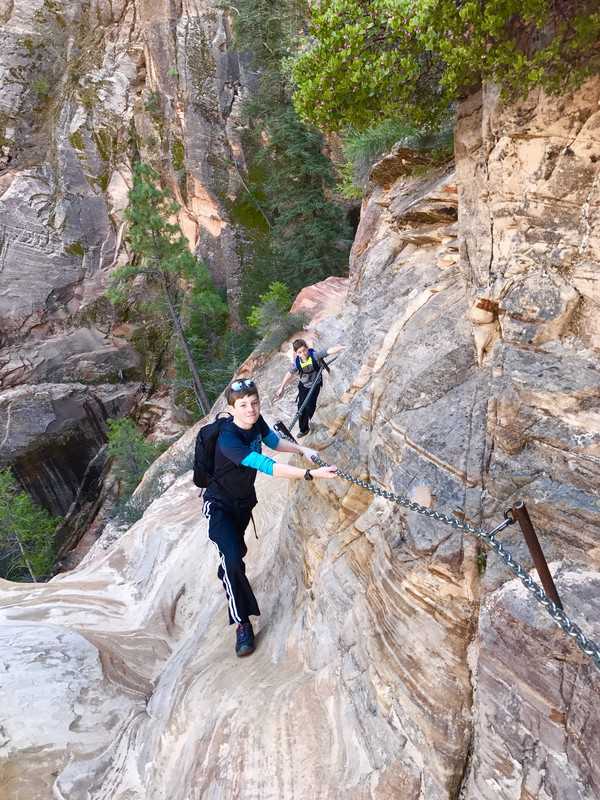
Lyn’s family did the Hidden Canyons hike as their main hike one day, which has drop-offs only on one side with chains to hang on to. She saw many people of all ages, pregnant and even with kids on their shoulders navigating this hike, and her family lived to tell the tale.
This is a 2.5-mile hike that takes about 3 hours and has a mix of the best of Zion from a steep incline to start to the sheer drop-offs as you navigate along rock cliffs to a super fun portion at the top where there’s lots of rocks to climb through, over and under (Lyn’s boys’ favorite part!).
If you’re afraid of heights, this one probably isn’t for you. Lyn is, but she managed the hike, though she was fearful the whole time that her younger, less-cautious son would fall off. He didn’t 😉. Before adding this hike to your agenda, look here. Mother Nature sometimes has her own way of giving the land a rest!
Check out their video of the hike below…
Rock “Scrambling”
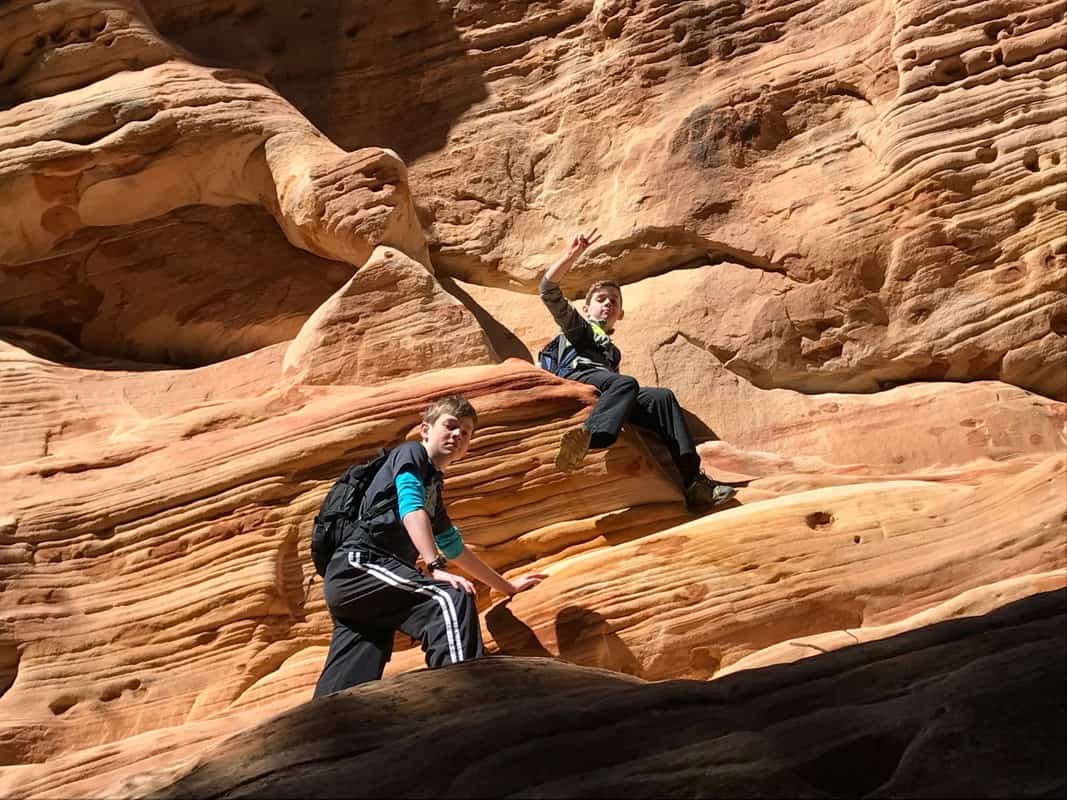
A great activity in Zion is what’s called rock “scrambling.” This just means climbing over, under, through and around rocks; it’s not actually rock “climbing,” as in scaling a rock. It can be quite challenging at times and test your brain power to figure out the best way through.
Lyn’s boys absolutely loved the rock scrambling (see video above), which you can also find in abundance at Joshua Tree National Park in California.
Wildlife Spotting

Zion is home to abundant wildlife. Lyn and her family were welcomed into the park, shortly after arriving, with desert bighorn sheep butting heads in the road. So cool! These are most frequently seen on the east side of the park.
Other wildlife includes mule deer, lizards, the desert tortoise and lots of birds.
Horseback Riding

Zion offers horseback riding tours starting at the corral near the Emerald Pools Trailhead if you’d like a completely unique way to see the park. We spotted them crossing the river while on one of our many hikes.
Stargazing
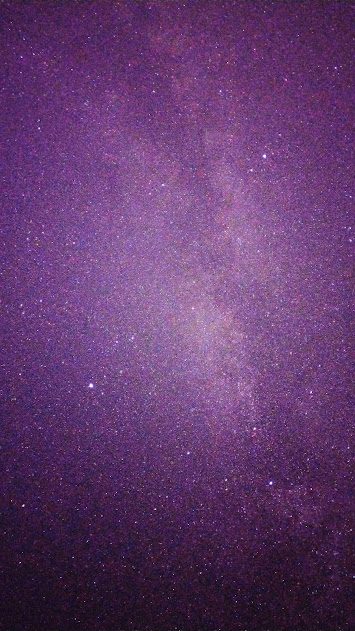
My husband has the star-gazing app, Sky Map, on his phone, which we like to use while visiting National Parks. When outside city limits, we’re among some of the darkest skies we’ve never seen, which is why Zion is a certified International Dark Sky Park.
Once your eyes adjust to the darkness, star formations will soon appear overhead, and you’ll be able to identify, wherever you are in the world (even Australia), what you are seeing just by pointing your phone at them. And with the latest phones, you can even set your phone on top of the car and fix the settings to capture a picture of the Milky Way as seen in the picture above.
Where to Eat in and Around Zion

Here are some options for dining in Zion National Park and in the surrounding towns…
- Red Rock Grill at the National Park Lodge
- Castle Dome Cafe, seasonal, at the National Park Lodge
- Bit and Spur, Springdale
- Camp Outpost, Springdale
- Oscar’s Cafe, Springdale (double double yummy yummy!)
- Cordwood, Zion Mountain Ranch
- Iron Horse, Kanab (so fun!)
- Rocking V Cafe, Kanab
- Sego Restaurant, Kanab
- Escobar’s Mexican, Kanab (a favorite of Lyn’s family)
What to Bring
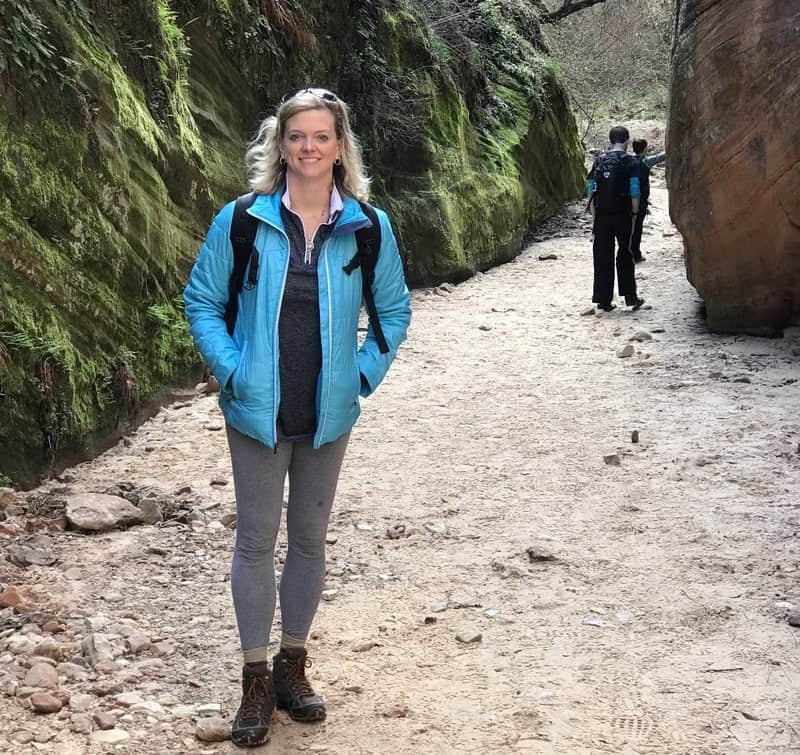
Because there’s a lot of water in Zion, you may want to bring waterproof shoes for hiking or even waders if you’re going to be hiking The Narrows. Or you can rent gear from Zion Guru like we did.
Do you recall the mention above of temps soaring up to 100 degrees? You’ll need to pack sunscreen, a hat and some sunglasses to ward off those damaging rays. But because it can be cool in the morning, be sure to bring layers.
When Lyn visited, they started off wearing jackets (shown above) and were sweating to death by the afternoon when it reached the low 80s. A light, puffy jacket is perfect for shedding later and stuffing it into a backpack!
If you decide to participate in evening ranger talks, bring along a flashlight or headlamp. Red LED flashlights help preserve night vision and decrease the overall light signature in low-light situations.

Like to stop at picnic tables or creekside for an impromptu picnic? Bring a small throw blanket or tablecloth to ensure that only it will get dirty and not you and your food.
Remember all the rock scrambling? You’re definitely going to want a first-aid kit for those inevitable scrapes and cuts that result as you climb over and through rocks 😉. A little Neosporin wouldn’t hurt either!
Check out our post on 7 Top Tips for Visiting Our National Parks for more National Park tips.
Want a detailed itinerary of an 8-day trip to see Zion and Bryce Canyon National Parks? Join the Families Fly Free membership to not only learn Lyn’s process for how to EASILY always fly your entire family free to the parks and beyond, but to get access to our many videos with tips for visiting our favorite National Parks along with detailed itineraries for some of the most popular parks.
Read More:
- One Day Itinerary for the Grand Canyon South Rim
- The Ultimate Guide to Yellowstone National Park
- The Ultimate Guide to Bryce Canyon National Park
- The Ultimate Guide to Grand Teton National Park
- The Ultimate Guide to Rocky Mountain National Park
- Moab Hotel, Gravity Haus, Top Choice When Visiting Arches National Park
- 32 Incredible Things to Do in Las Vegas
- Grand Canyon North Rim and South Rim: Your Ultimate Guide
Author
-

Cami Sauder, a member of the Families Travel Free team, is a longtime traveler who aims to be away from home at least 1/3 of the year. She's mastered the art of using miles and points to save on flights and hotels and saved more than $16,000 on travel using points in the last year. She and her husband have a goal to see as many National Parks as possible.
